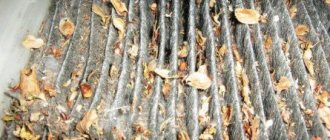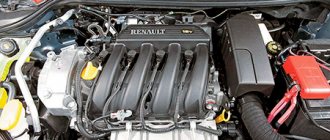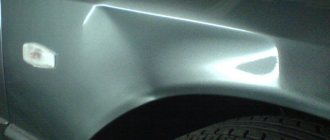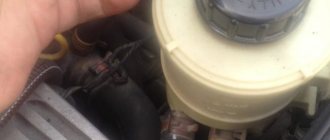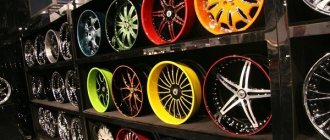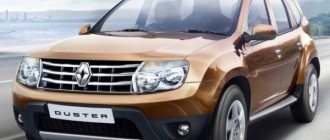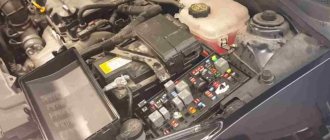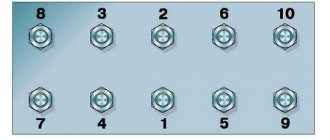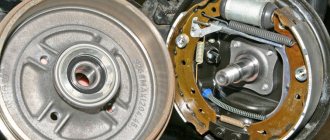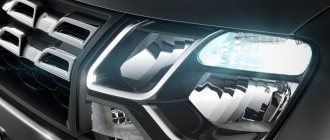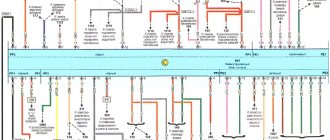Production of Renault F4R 2.0 liter engines began in 1993. During its life, the engine was modernized more than once, but at the same time retained its main design features. The main one is a cast-iron cylinder block with pressed liners, making it possible to carry out major repairs (carried out by re-lining). The F4R engine's timing system is DOHC, which means it has two camshafts, in this case belt driven. For each cylinder there are 4 valves with hydraulic compensators, eliminating the need to adjust the thermal gap. A distributed injection system is responsible for supplying fuel. Reducing fuel consumption and improving engine performance is ensured by a phase regulator.
The F4R engine is installed on many Renault models of different generations. The current version of the power unit with a compression ratio of 11.1:1 is installed under the hood of the popular Renault Duster and Renault Kaptur crossovers in Russia. On both models, the engine produces 143 hp. (at 5750 rpm) and torque 195 Nm (at 4000 rpm). In general, the engine is considered very reliable and does not cause much trouble to owners. If you change the oil according to the regulations and respond in a timely manner to emerging failures, you can count on a long service life of the unit. Based on practice and reviews from owners, the resource reaches 250-350 thousand km.
Specifications Renault F4R
| Years of manufacture | 1993 – present |
| Place of production | Spain France |
| engine's type | petrol |
| Supercharging | No |
| Supply system | injector (MPI) |
| Cylinder configuration | R4 |
| Valves per cylinder | 4 |
| Timing type | DOHC |
| Timing drive | belt |
| Cylinder block | cast iron |
| Cylinder head | aluminum |
| Working volume | 1998 cm³ |
| Cylinder diameter | 82.7 |
| Piston stroke | 93.0 |
| Compression ratio | 9.8:1 11.1:1 (Duster, Kaptur) |
| Cylinder operating order | 1-3-4-2 |
| Power | 130-143 hp |
| Torque | 190-195 Nm |
| Fuel type | gasoline AI-92/AI-95 |
| Environmental class | Euro 4/5 |
| Hydraulic compensators | Yes |
| Phase regulator | Yes |
| Catalyst | Yes |
| Lambda probe | Yes |
| EGR | No |
| What kind of oil to fill | 5W-30 5W-40 |
| Oil volume | 4.8 liters |
| Engine weight | 130 kg |
| Approximate resource | 250,000 km |
F4R engine malfunctions and repairs
Engine Renault F4R 2.0 l. 135-138 hp (depending on the index), the latter became especially popular thanks to the popular Renault Duster SUV and the Megan family. There are a number of different modifications of the F4R, with various indices, their power varies within narrow limits, from 135 to 138 hp. The index shows the car for which this engine was intended (mounts) and the engine settings. Almost all parts of the F4R are interchangeable and the differences are mainly in the attachments. In addition to the usual variations, there are also sports ones - used on the Clio Sport with power from 169 hp. up to 200 hp Their differences: electronic throttle valve, different air filter, steel crankshaft (instead of cast iron), modified cylinder head, exhaust. I would like to immediately put an end to the issue of a belt or chain on the Duster engine; the engine has a timing belt drive. F4R itself is not new enough, all its disadvantages are known and the causes of malfunctions are known. Let's look at the most popular faults of the F4R 2.0: the phase regulator, it fails once every 60-70 thousand km, this will be indicated by the sound of the engine reminiscent of a diesel engine, in addition, such a sound may indicate more serious problems (cracked cylinder head, burnt out piston, valve) , one way or another you need to measure the compression and proceed from that. Ignition coils do not last long; when the F4R Duster engine fails, it begins to twitch, this is the main reason, besides it, the issue may be in the crankshaft position sensor (crankshaft position sensor) or in the spark plugs. The throttle valve likes to get clogged and your Renault F4R does not start in the best way; after cleaning, the problem disappears as if by hand. The rear crankshaft oil seal, likes to leak on engines with mileage over 100 thousand km, can be changed without problems. The Duster engine speed fluctuates, this is a feature of the engine, it’s not scary. Speaking about the features, you need to note one more thing, the noise of the Renault Duster engine in the timing belt area, this is also not scary. In addition to everything written above, the Duster F4R engine is characterized by increased oil consumption. Despite everything, the motor is quite decent and will not cause any special problems during normal operation; the service life of the Duster engine is 250-300 thousand km before major repairs. Choosing a car Duster/Megan, etc. look at the 2 liter engine, the 1.6 K4M will not be enough.
What car models are equipped with the F4R engine?
| Model | Years of manufacture |
| Nissan Terrano (3rd generation) | 2014 – present |
| Renault Clio (3rd generation) | 2005 – 2009 |
| Renault Clio (3rd generation restyling) | 2009 – 2011 |
| Renault Duster (1st generation) | 2010 – 2015 |
| Renault Duster (1st generation restyling) | 2015 – present |
| Renault Captur | 2016 – present |
| Renault Laguna (2nd-3rd generation) | 2001 – 2010 |
| Renault Megane (2nd generation) | 2002 – 2006 |
| Renault Megane (2nd generation restyling) | 2006 – 2009 |
| Renault Megane (3rd generation restyling) | 2012 – 2014 |
| Renault Megane (3rd generation 2nd restyling) | 2014 – 2016 |
| Renault Scenic (2nd generation restyling) | 2006 – 2009 |
List of internal combustion engine modifications
Initially, engine characteristics are adjusted by the manufacturer for various Renault vehicles, so F4R engines are assigned several indices. For example, for Renault Duster the indexes 400 (all-wheel drive), 402 (automatic transmission), 403 and 405 (manual transmission) are used.
Various attachments are used, including the intake manifold. The compression ratio varies in the range of 9.5 – 9.8 units, although in the basic version of the internal combustion engine it is 11 (index 730).
Intake manifold option F4R
The valve lift heights in the F4R730 internal combustion engine are 9.999 mm and 10.998 mm (intake/exhaust, respectively). In modifications F4R701, 740, 741 and 780 it is 10.014 mm and 10.009 mm (intake/exhaust, respectively).
The base engine is equipped with short valve springs of 41.3 mm, and all other modifications have springs of a different length - 43.57 mm in the free position. The valve timing differs by 3 and 19 degrees (intake/exhaust, respectively).
Turbo version F4Rt
In addition to atmospheric modifications of the power drive, the manufacturer produces a turbo version of the F4Rt with the following characteristics:
- power – from 168 hp. With.;
- torque – from 340 Nm;
- supercharger - turbine;
- fuel - AI-95/98.
This engine is equipped with an intercooler to cool the air flow at the inlet for greater compression.
The curse of Duster or the most optimal engine? Should you be afraid of the F4R engine in the Renault Duster?
03/27/2020, 04:00 / Auto
The reliable Duster engine can become a problem under one condition.
Petrol 2-liter F4R engine with maximum power from 130 to 203 hp. depending on the degree of boost, it has become a subject of controversy among Russian motorists: some believe that this is the most optimal engine for a crossover, others are sure that this is the curse of the Duster. Should you be afraid of the F4R engine in the Renault Duster? It’s time to figure it out.
Renault began producing this engine back in the 90s of the last century, which means the design is old and long proven - it is believed that in gentle use mode the engine is capable of running for about 350,000 km. And although the Renault Duster engine is slightly inferior in terms of power, it “presses” with resources - competitors travel 50, or even 100 thousand km less. Everything seems to be fine, but the problems really began in 2016, after the F4R engine was modernized.
Since then, owners of 2-liter Renault Dusters began to end up in car repair shops with a breakdown of the power unit, which barely managed to last 120-150 thousand kilometers: guide bushings break, rings wear out and become clogged with soot, and sometimes the piston partitions burst. But there is an explanation for this problem.
Which motor is better to choose?
We looked at all available units for the French crossover. Now let's try to determine which one is better. Let us immediately note that each of the options has its own advantages, therefore, when making a choice, you need to build on your own preferences and operating conditions. For example, a diesel engine, weak at first glance, has stunning torque, which allows it to “take off”. A significant drawback is the lack of an automatic transmission. However, manufacturers promise that this will be corrected in subsequent generations of the model. Let's hope so.
From a price/quality point of view, the best option is a junior petrol unit. We recommend this modification to those who want to purchase a “big one” for relatively little money. The main advantage is the presence of both manual and automatic transmissions. The same can be said about the two-liter gasoline engine. Naturally, it is more powerful, which allows you to count on impressive performance indicators. Watch at least one test drive of Renault Duster 2.0 and you will see for yourself.
Now let's move on to the topic that most interests Russian car enthusiasts - fuel consumption. Its figure is the lowest for a diesel engine - about 5 liters in mixed mode. This is quite predictable and should not surprise anyone. With gasoline engines everything is more complicated. The most voracious is the two-liter unit. We will not name passport numbers now, since they often differ from the actual ones. We advise everyone to independently study the reviews of real Duster owners on this matter and draw their own conclusions.
The ideal option is to test the Duster engines yourself. To do this, just sign up for a test drive at an official dealer. Unfortunately, not every dealer can offer diesel and finding this modification is very difficult. But there are no problems with gasoline versions - there are more than enough of them.
1.6 petrol engine
1.6 petrol engine
The torque of the 1.6 liter engine is 148 N/m (3750 rpm). This engine is equipped with a manual transmission: 5-speed with front-wheel drive, for all-wheel drive - 6-speed. The all-wheel drive option will provide flexible control of the crossover in a variety of situations. Fuel consumption in the city reaches 12 liters, on the highway – 8 liters, and with mixed driving – 9 liters. Each driver has his own driving style, so average data is given. The front-wheel drive option is more attractive and affordable for buyers, as it is more economical. For the front-wheel drive model, average fuel consumption is 11 liters in the city, 7.5 liters on the highway, and 8.5 liters with mixed driving.
Renault Duster 2.0 (143 hp) 6MT 4WD - Technical specifications
Renault Duster benefit up to 170,000 rubles! Do not miss!
Renault News
| Expression | Privilege | Luxe Privilege | DAKAR Edition | |
| Serial equipment included in the price of the vehicle | ||||
| Limited edition Dakar equipment | ||||
| Thema Black 16" alloy wheels | ||||
| Chrome rear bumper guard with Dakar name in 3D letters | ||||
| Black wheel arch extensions | ||||
| Decorative body stickers in black with Dakar inscription | ||||
| Dakar special edition badge on the front doors | ||||
| Textile floor mats with Dakar lettering | ||||
| Chrome front door sills with Duster lettering | ||||
| Design | ||||
| New chrome grille | ||||
| Newly shaped front and rear bumpers | ||||
| Longitudinal rails of a new shape, black | ||||
| Longitudinal roof rails of a new shape, painted in chrome | ||||
| Trim for the trunk door with the name Duster with three-dimensional letters | ||||
| Rear view mirrors black | ||||
| Rear view mirrors in body color | ||||
| Rear view mirrors painted chrome | ||||
| Chrome bumper protection front and rear | ||||
| Decorative trim for exhaust pipe | ||||
| Front and rear mudguards | ||||
| Steel wheels 16?? standard | ||||
| Alloy wheels ACONIT 16?? | ||||
| Light window tinting | ||||
| Rear windows heavily tinted | ||||
| Interior | ||||
| Fabric upholstery (combination of dark gray and black) | ||||
| Fabric upholstery with 3D effect inserts in black | ||||
| Leather seat upholstery* | ||||
| Leather steering wheel | ||||
| Control | ||||
| Cruise control | ||||
| Power steering | ||||
| On-board computer | ||||
| Lighting | ||||
| Daytime Running Lights | ||||
| Headlights with dual optics | ||||
| Rear lights stylized as LED | ||||
| Central interior lighting | ||||
| Fog lights | ||||
| Luggage compartment lighting | ||||
| Glove box lighting | ||||
| Comfort | ||||
| New seats | ||||
| Renault Start remote engine start system ***** | ||||
| Heated windshield | ||||
| Soundproofing package | ||||
| Gear shift indicator | ||||
| Eco mode | ||||
| External temperature sensor | ||||
| 12-volt socket for rear passengers | ||||
| Keyless access to the gas tank | ||||
| Air recirculation | ||||
| Air conditioner | ||||
| Heated front seats | ||||
| Heated rear window | ||||
| Front electric windows | ||||
| Rear electric windows | ||||
| Driver's side power windows | ||||
| Aspherical driver's side exterior mirror | ||||
| Electrically adjustable and heated exterior mirrors | ||||
| Adjusting the driver's seat height (using the handle on the left side of the seat) | ||||
| Steering wheel height adjustment | ||||
| 1/3 2/3 folding rear seat backrest | ||||
| Central locking with remote control | ||||
| Rear parking sensors | ||||
| Audio system CD-MP3 + AUX + USB + Bluetouth + steering column joystick | ||||
| Trunk shelf with compartments for small items | ||||
| Safety | ||||
| ABS with electronic brake force distribution + AFU | ||||
| Driver airbag | ||||
| Passenger airbag | ||||
| Front side airbags | ||||
| 2 rear headrests | ||||
| 3 rear headrests | ||||
| ISOFIX fastening system on the rear outboard seats | ||||
| Three-point seat belts in the front seats with force limiters | ||||
| Adjusting the height of seat belts on the front seats | ||||
| Adaptation to Russian conditions | ||||
| Adapting the engine to start in cold climates | ||||
| Engine crankcase protection | ||||
| Manufacturer's warranty 3 years or 100,000 km (whichever comes first) | ||||
| Anti-corrosion protection: 6 years manufacturer's warranty | ||||
| Optional equipment | ||||
| Metallic paint | RUB 15,990 | RUB 15,990 | RUB 15,990 | RUB 15,990 |
| Safety package 1: passenger airbag + third rear headrest | RUB 7,990 | |||
| Safety Package 2: Passenger Airbag + Front Side Airbags | RUR 16,990 | RUR 16,990 | ||
| “Winter” package: heated windshield + heated front seats | RUB 14,990 | |||
| ESP (Stability Program) + HSA (Hill Start Assist)*** | RUB 15,990 | RUB 15,990 | RUB 15,990 | RUB 15,990 |
| Ashtray and cigarette lighter | RUB 1,990 | RUB 1,990 | RUB 1,990 | RUB 1,990 |
| Rear parking sensors | RUB 7,990 | RUB 7,990 | ||
| Multimedia package 1: Updated Media NAV multimedia navigation system with AUX, USB, Bluetouth ****, steering column joystick, hands-free function | RUR 11,990 | |||
| “Multimedia 2” package: Media NAV multimedia navigation system with AUX, USB, Bluetouth****, steering column joystick, hands-free function + rear view camera + rear electric windows + rear parking sensors | RUB 26,990 | RUB 26,990 | ||
| “Multimedia 3” package: Media NAV multimedia navigation system with AUX, USB, Bluetouth****, steering column joystick and hands-free function + rear view camera | RUB 14,990 | |||
| Driving Comfort Package: Fog lights + cruise control | RUR 9,990 | |||
| Renault Start remote engine start system ***** | RUR 6,990 | |||
| Aconit 16″ alloy wheels | RUR 9,990 | |||
| Thema Black 16" alloy wheels******* | RUR 11,990 | |||
| Accessories with installation | ||||
| Protection package NEW | RUB 10,990 | RUB 10,990 | RUB 10,990 |
Advantages and disadvantages
In addition to the obvious minus - bending of the valves by the pistons in the event of a sudden timing belt break, and the plus - a service life of 250,000 km, the F4R engine has the following advantages:
- The COP ignition system is considered the most advanced today, since the individual coil on each spark plug efficiently accumulates charge, and there is no high-voltage wire bundle.
- the high-life pump is designed for the entire service life of the internal combustion engine, which reduces operating costs;
- hydraulic compensators make it possible to do without constant adjustment of thermal valve clearances;
- phase regulator reduces fuel consumption, improves engine performance;
- The cast iron block has a long service life and is suitable for major repairs by re-sleeving.
F4R pump
On the other side:
- the cylinder head, valves and intake manifold are individual for each engine version, which makes repairs difficult;
- The service life of the phase regulator in practice does not exceed 60 thousand mileage, then it needs to be repaired;
- the quality of ignition coils is often unsatisfactory, and their quantity increases the cost of repair and maintenance fourfold;
- When replacing a pump, you have to change both the timing belt and the attachment belts.
Replacing the timing belt
However, Renault management tried to make life as easy as possible for users:
- major repairs can be done with ordinary tools with your own hands;
- it is possible to boost the power drive with a turbine and upgrade it mechanically.
An important feature of the power unit is the increased volumes of the combustion chambers in comparison with previous engines of the same series.
Renault Duster
Renault Duster is a small budget urban crossover developed by a subsidiary of Dacia in 2009. The Duster was created on the Renault-Nissan B0 platform, on which the popular models Renaul Logan, Renault Sandero, Lada Largus, Lada XRAY, Renault Kaptur, as well as Nissan Tiida, Nissan Note, Nissan Almera and other cars were developed. In addition, the car also has a twin brother, in the form of the Nissan Terrano. Since the end of 2020, the second generation of this car has been produced, still under the Dacia brand.
Duster engines are a small line of 1.6-liter K4M, the same volume H4M and 2-liter F4R. There is also a K9K diesel engine with a displacement of 1.5 liters. The Romanian version also has a 1.2 liter turbo engine. As for the Duster 2 engines, the 1.6-liter engine remained the same - H4M, the turbocharged 1.2-liter 125-horsepower engine and the K9K diesel engine were left - all unchanged.
Here we will look at the features and malfunctions of all these engines, their repair, what oil to pour and how often, engine life and tuning. After reading this information, you will automatically no longer have the question of which Renault Duster engine is best for you.
